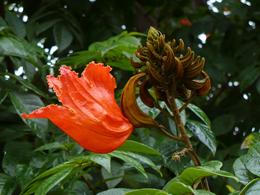News
Hopping the fence
Botanic gardens could do more to stop the escape of non-native species.
 Botanic gardens have sometimes been the source of invasive species like this African Tulip Tree.sree314/flickr
Botanic gardens have sometimes been the source of invasive species like this African Tulip Tree.sree314/flickrModern botanic gardens are much more than just attractive strolling grounds. Many have labs in which botanists and taxonomists ply their trade. And many take an interest in conservation of the world's flora, often by fostering rare species.
But they aren't always a force for good when it comes to conservation, according to a study by Philip Hulme, a weed specialist at Lincoln University in New Zealand1. Hulme says that many invasive plant species escaped from botanic gardens, and that the gardens do not do enough to keep their collections in check.
Hulme got the idea for the research in Tanzania. The field site he was visiting was near a botanic garden, and he could see that many of the plants in the site had come from the garden. "A lot of the species were spreading into the forest," he says.
Hulme first looked at the 34 plants on an International Union for Conservation of Nature list of 100 of the worst invasive species. For 19 of the 34, there was evidence that they may have escaped from botanic gardens. For example, the Brazilian fruiting tree known as strawberry guava (Psidium cattleianum), which runs riot all over the Hawaiian Islands, is thought to have jumped the fence from the Harold L. Lyon Arboretum in Honolulu in the early 20th century.
Misguided
Most of these events were long ago, back when some gardens were trying to get non-native — or alien — plants to naturalize in new places, or at least knew nothing of the threat they might pose to native ecosystems. So Hulme decided to check whether botanic gardens had since cleaned up their act.
To find out, he looked at whether areas with more botanic gardens had more alien plants living there. He used published accounts of the Gross Domestic Product, population density and alien species diversity of 26 counties. Then he added to the mix the number of botanic gardens per unit area, using a master list of gardens kept by Botanic Gardens Conservation International (BGCI), a global network of botanic gardens that is based in London. He discovered that they did, although the effect was not strong once the prosperity of the region and the number of people living there were accounted for. But 12% of the variation in alien-plant richness seems to be down to botanic gardens.
Hulme does point out that he has found a correlation, not a causal relationship. High numbers of gardens and alien species might both be the result of some third factor. "Does it reflect cultures that are really keen on horticulture?" he asks. Whatever the reason, Hulme thinks the figure should be enough to make garden managers take notice.
According to Hulme, few gardens have signed onto voluntary pledges such as the St Louis Declaration, wherein they promise to keep an eye on potential invasive plants, and few have undertaken any kind of risk assessment of their operations. "I just wanted to prick the conscience of botanic gardens," he says.
All abuzz
Stephen Blackmore, head of the Royal Botanic Garden Edinburgh, UK, says that the botanic-garden community has been buzzing about Hulme's paper. Many of the managers that he's corresponded with feel that the picture Hulme paints is a bit simplistic. In particular, Blackmore says, many share the sense that the era of botanic gardens as intentional introducers of plants to new areas is long past and that, these days, home gardeners and the horticultural trade are more likely sources of new invasive species.
"I am not saying that that lets botanic gardens off the hook," says Blackmore. He agrees that the issue is an important one to highlight. But he also says that many gardens take steps to limit the danger of unwanted escapees. At his garden, he says, new specimens from abroad are held in quarantine houses until they've been checked for diseases or fungus that might pose a threat. And its shop doesn't sell anything that is considered invasive.
Meanwhile, BGCI is beginning a project with the Council of Europe to develop guidelines about the management of alien and invasive species in European botanic gardens, according to Suzanne Sharrock, director of global programmes at the BGCI. The guidelines will then be adapted for the BGCI's members beyond Europe and folded into the organization's general guidelines for botanic gardens interested in conservation. She expects a draft of the European version of the guidelines to be available by August.
Widespread adoption of such guidelines might just change the plants and trees that visitors see at botanic gardens. Hulme says some showy but potentially invasive species, such as the African Tulip Tree (Spathodea campanulata) are commonly planted in "a bit of laziness" because "everybody likes them". There are, he contends, plenty of pretty trees that don't have a tendency to run wild.
Comments
If you find something abusive or inappropriate or which does not otherwise comply with our Terms or Community Guidelines, please select the relevant 'Report this comment' link.
Comments on this thread are vetted after posting.
There are currently no comments.
Add your own comment
This is a public forum. Please keep to our Community Guidelines. You can be controversial, but please don't get personal or offensive and do keep it brief. Remember our threads are for feedback and discussion - not for publishing papers, press releases or advertisements.
You need to be registered with Nature to leave a comment. Please log in or register as a new user. You will be re-directed back to this page.

Nenhum comentário :
Postar um comentário